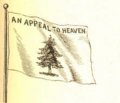Pine Tree Flag facts for kids
The Tree Flag (also known as the Appeal to Heaven Flag) was an important flag used during the American Revolution. This flag featured a green pine tree and the words "An Appeal to Heaven" on a white background.
General George Washington first used this flag in October 1775. He ordered it for a group of six ships that were part of the new Continental Army. Today, it is the official flag for ships in the state of Massachusetts, though the words were removed in 1971.
Contents
Flag Design
The idea for the flag came from Colonel Joseph Reed. He was General Washington's secretary. On October 21, 1775, Reed suggested the design.
He wrote that the ships should use "a flag with a white ground and a tree in the middle." He also added that the flag should have "the motto AN APPEAL TO HEAVEN." A year later, Massachusetts officially adopted this design for its state navy.
Pine Tree Symbolism
The pine tree was a very important symbol in New England for a long time. Native American groups like the Iroquois valued the pine tree. They called it the "tree of peace."
Colonists also started using the pine tree as a symbol. It appeared on flags and even on money in the 1600s. Before the American Revolution, the pine tree became a sign of colonial anger against British rules. It also showed support for independence.
Pine Trees and Ships
The eastern white pine trees in New England were very tall and strong. This made them perfect for building ships. The Pilgrims started cutting these trees soon after they arrived in 1620. They even exported the wood to faraway places.
England needed these large trees for its Royal Navy ships. So, in 1691, the British government passed a law. This law said that certain large pine trees in the colonies belonged to the King. Surveyors would mark these trees with a special symbol called the "broad arrow."
However, colonists often ignored this rule. They would cut down the marked trees and sell them illegally.
Pine Tree Riot
In 1772, this rule led to a protest called the Pine Tree Riot in New Hampshire. A mill owner was fined for having trees marked with the broad arrow. He refused to pay.
Angry colonists then attacked the sheriff and his deputy. They whipped them and cut the ears and tails off their horses. This event happened almost two years before the famous Boston Tea Party. It was one of the first strong protests against British policies.
Pine Tree on Flags
Some people believe the pine tree was used on a flag at the Battle of Bunker Hill in June 1775. However, this is debated by historians today. The most accepted flag for Bunker Hill had a red background with a green pine tree.
The pine tree was a good symbol for the new American warships. It showed the colonists' connection to their land. It also showed their defiance against the British, who wanted to control their valuable timber.
"Appeal to Heaven" Meaning
The phrase "An Appeal to Heaven" comes from a famous British philosopher named John Locke. He wrote about the idea of the right of revolution in 1690.
Locke believed that if a government acts unfairly and people have no other way to get justice on Earth, they have the right to "appeal to heaven." This means they can ask for a higher judgment, even if it means fighting for their rights.
Colonial leaders knew Locke's writings very well. They often quoted him. His ideas greatly influenced the American philosophy of government. Many leaders saw the Declaration of Independence as following Locke's ideas.
Before the Pine Tree Flag was created, the phrase "an appeal to Heaven" was used by colonists in other ways. It appeared in speeches and official documents. This showed that the colonists felt they had no other choice but to fight for their freedom.
Images for kids





